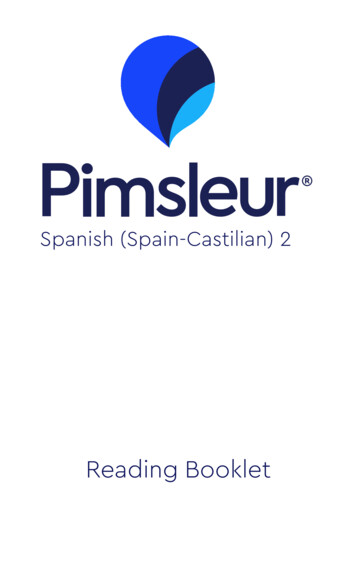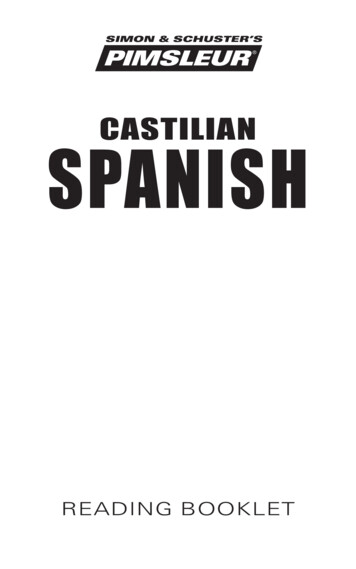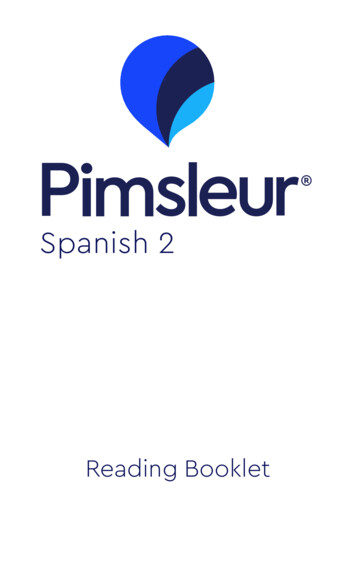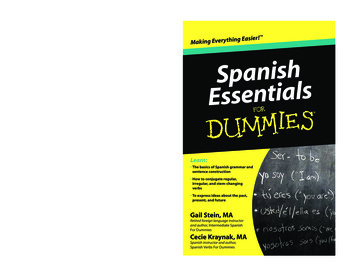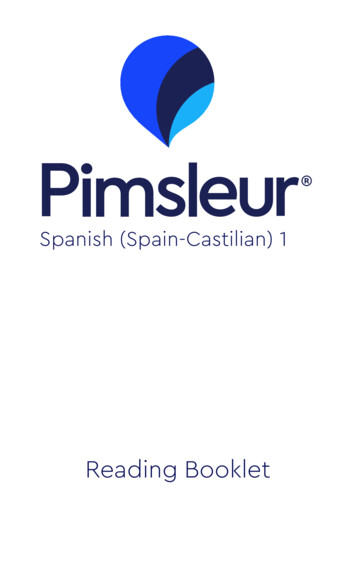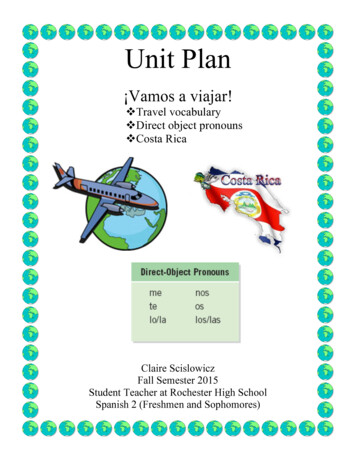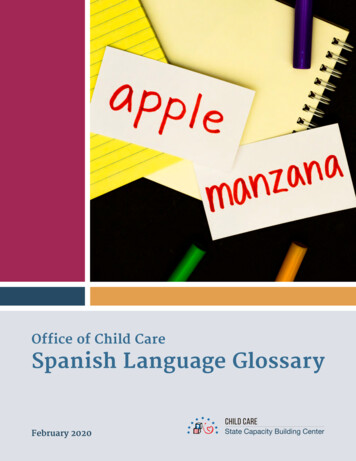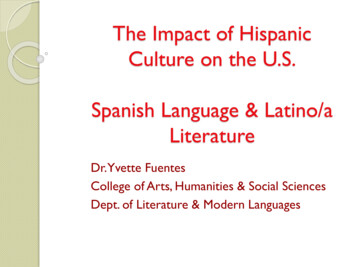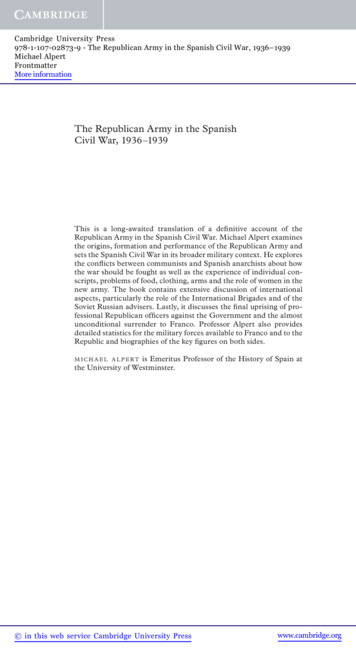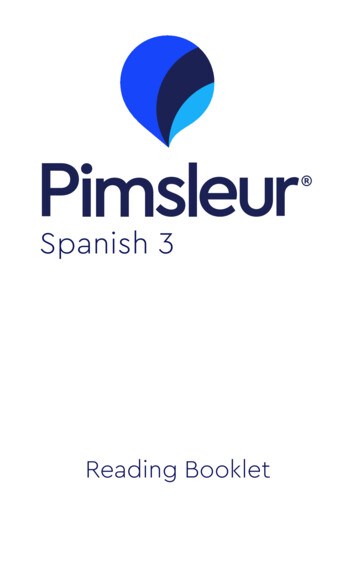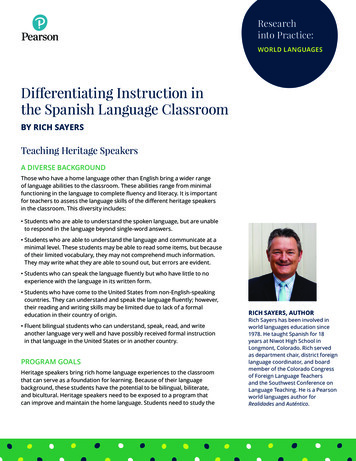
Transcription
Researchinto Practice:WORLD LANGUAGESDifferentiating Instruction inthe Spanish Language ClassroomBY RICH SAYERSTeaching Heritage SpeakersA DIVERSE BACKGROUNDThose who have a home language other than English bring a wider rangeof language abilities to the classroom. These abilities range from minimalfunctioning in the language to complete fluency and literacy. It is importantfor teachers to assess the language skills of the different heritage speakersin the classroom. This diversity includes: Students who are able to understand the spoken language, but are unableto respond in the language beyond single-word answers. Students who are able to understand the language and communicate at aminimal level. These students may be able to read some items, but becauseof their limited vocabulary, they may not comprehend much information.They may write what they are able to sound out, but errors are evident. Students who can speak the language fluently but who have little to noexperience with the language in its written form. Students who have come to the United States from non-English-speakingcountries. They can understand and speak the language fluently; however,their reading and writing skills may be limited due to lack of a formaleducation in their country of origin. Fluent bilingual students who can understand, speak, read, and writeanother language very well and have possibly received formal instructionin that language in the United States or in another country.PROGRAM GOALSHeritage speakers bring rich home language experiences to the classroomthat can serve as a foundation for learning. Because of their languagebackground, these students have the potential to be bilingual, biliterate,and bicultural. Heritage speakers need to be exposed to a program thatcan improve and maintain the home language. Students need to study theRICH SAYERS, AUTHORRich Sayers has been involved inworld languages education since1978. He taught Spanish for 18years at Niwot High School inLongmont, Colorado. Rich servedas department chair, district foreignlanguage coordinator, and boardmember of the Colorado Congressof Foreign Language Teachersand the Southwest Conference onLanguage Teaching. He is a Pearsonworld languages author forRealidades and Auténtico.
grammar and focus on vocabulary development.Emphasis should be placed on building reading andwriting skills. It is important that students developa sensitivity to when standard and non-standardlanguage should be employed and comfortably adjusttheir language accordingly. In addition, studentsshould be exposed to the diverse cultures within theSpanish-speaking community while developing a senseof pride in their own heritage. Heritage speakers needto reach a high level of proficiency and accuracy thatwill ensure success at the advanced level of languagestudy and testing. These students should also be readyto transition into a focused study of Spanish in specificprofessional areas.“These groups needdifferent materials, differentinstructional approaches,and different objectives.” Maintain high standards. Require students to focus onaccuracy and proficient communication. Many heritagespeakers experience frustration with reading andwriting in the home language when they have goodaural/oral skills. Building language skills takes time.FOCUS ON INDIVIDUAL NEEDSDue to their diverse backgrounds, heritagespeakers differ greatly in language skills and mayneed individualized instruction. In many of today’sclassrooms, teachers encounter classes that containa mixture of beginning-level students and heritagespeakers. These groups need different materials,different instructional approaches, and differentobjectives. Here are several strategies that maybe helpful for heritage speakers:Teaching Spanish to Students withLearning DisabilitiesThere are many reasons why students may experiencedifficulties in learning a second language. In general,these difficulties may be characterized by the inability tospell or read well, problems with auditory discriminationand in understanding auditory input, and difficulty withabstract thinking. Research by Ganchow and Sparks(1991) indicates that difficulties with one’s first languageare a major factor in foreign language learningdifficulties. It is not always evident which students willexperience difficulties with learning a second language.Many times these students are bright and outgoing.They may have experienced reading or spellingproblems in elementary school, but they have learnedto compensate over time. Ask students what problemsthey may have experienced with their first language,especially in the areas of reading and dictation. Build upon their background knowledge. Developinstructional units around themes and topics thatrelate to their life experiences. Encourage students touse these experiences as the foundation for buildinglanguage skills through vocabulary development,reading, and writing. Help students connect aural with written language.If students don’t understand a word in a reading, havethem read it aloud or ask a friend or teacher to readit aloud. Often they can recognize the word once theyhear it. Allow for opportunities for students to followalong as a story is read aloud. Use strategies that are effective in a languagearts classroom, such as building schema, teachinglanguage-learning strategies, using graphic organizers,and incorporating pre- and post-reading tasks. Use thewriting process to develop good writers.ACCOMMODATING INSTRUCTIONStudents with learning disabilities can develop alevel of proficiency in a second language with somemodifications to instruction and testing. These learnersbenefit from a highly structured approach that teachesnew content in context and in incremental amounts.Teach, practice, and assess using multi-sensorystrategies. Many students benefit when instructioncombines seeing, hearing, saying, and writing. Encourage students to begin communicating,especially in writing. Have them write down theirthoughts in the way they sound to them. Then havestudents work with the teacher or another student forcorrections. Students can also look through textbooksand dictionaries to assist with error correction.2
Limit background noises that may distract students.Avoid seating these students where they may hearextraneous noise.For example, a teacher would first show a visual of aword and say it aloud. This is followed by using the newword in context. The teacher then writes the word onthe board. Students would say the word aloud with theteacher. They then write it down and say it aloud again. Change listening activities and assessments toreading/writing activities. In activities that requireaural/oral skills, let students demonstrate skillsthrough alternative responses such as writing.“ Provide access to the audio and video materials asthey provide pronunciation support and modeling.Providing access to all listening activities, and accessto the vocabulary and grammar videos will these helpstudents further access and retain the content.Students with learningdisabilities can develop alevel of proficiency in asecond language with somemodifications to instructionand testing.VISUAL PERCEPTION PROBLEMS Help students access information provided visually.Allow for preferred seating in the front of the class,including providing space for a guide dog, if necessary.Avoid seating students where they will be distractedby extraneous auditory or visual stimuli. Give studentsadditional time to review visual input prior to an oralor written task. Highlight important information byproviding key words, visuals, and simple outlines.”In subsequent days, many students benefit fromfrequent reviews of learned auditory materials. rovide support for accessing printed information. PMake sure the print is easy to read. The readingsshould be designed to maximize readability: easy-toread font, layout, and design. Teach reading strategiesthat highlight the visual aspects of a selection: textorganization, use of visuals, titles and headers, and theuse of color. Provide copies of reading selections withadditional support: underline key words/sentences/concepts or magnify the text in duplication.Accommodations for Students withSpecial NeedsHere are suggestions for instruction of students withspecial needs. each, practice, and assess using multi-sensory Tstrategies.HEARING IMPAIRMENTS Help students comprehend oral information orinstructions. Provide written directions/materialsand/ or visual cues to support what is presented orally.Face the students when speaking, repeat as needed,and speak clearly. Seat these students in the frontof the classroom. Provide outlines of lectures or oralpresentations. Have another student take notes andmake copies of notes available to all students. Usingaudio and video scripts are also helpful for this studentpopulation. In addition, turning on the closed-captionfeature will benefit students with hearing impairments.Different Learning Modalities/IntelligencesStudents may have preferences in the way they learnand are able to better access and retain the contentwhen presented with the content and activitiesin a manner that takes advantage of their naturalinclinations and learning style. Here are a few: Allow students to refer to their textbooks or to otherwritten materials during oral presentations.3
MATHEMATICAL/LOGICAL LEARNERSspatial learning styles are good at visual problem solvingand visual estimation. According to experts, this groupof students learns best when taught using written,modeled, or diagrammed instruction and visual media.Visually and spatially talented students have good visualmemory for details.Learner with the ability to reason, solve problems,and learn via using numbers, abstract visualinformation, and analysis of cause and effectrelationships. Mathematical logical learners are typicallymethodical and think in logical or linear order. Theyfrequently prefer structured, goal-oriented activitiesthat are based on math reasoning rather than lessstructured, creative activities with inexact learninggoals. Students with mathematical logical learningstyles enjoy school activities such as math, computerscience, technology, drafting, chemistry and other “hardsciences,” and design. According to subject literature,mathematical linguistic learners prefer logical order ininstruction and often prefer organized and structuredenvironments. They are known to have strong visualanalysis and memory and problem solving skills.These students like to build and tinker and find it verymeaningful when they are able to bring mathematicaland conceptual ideas into reality via hands-on projectssuch as computer-assisted design, creating electronicdevices, and employing computer applications.Suggestions for this group of learners. Use activitiesthat include Interactive Whiteboard activities, moviesand videos. Use content that includes art, photography,maps and other realia such as surveys, recipes, etc. thatgive them a visual reference. In addition, Project-basedlearning where they have to create something tangiblesuch as a video, website, display etc. would be good forthis group of students. Tasks with written rubrics workwell with this student population.VERBAL/LINGUISTIC LEARNERSA verbal/linguistic learning style refers to a person’sability to reason, solve problems, and learn usinglanguage. This group of students will typically expressthemselves well and are usually good listeners with awell-developed memory for material they’ve read andrecall of spoken information. According to multiplesources, verbal linguistic learning styles learn best whentaught using spoken or written materials. Rather thanactivities that are based on abstract visual information,Verbal/Linguistic learners prefer those that are based onlanguage reasoning and they will usually enjoy writtenprojects. They love language and they enjoy learningnew words and exploring ways to creatively uselanguage, such as in poetry. Word games, reading,writing and memorizing tongue twisters and songsare activities that they are sure to connect with.Suggestions for this group of learners. Students withmathematical logical learning styles learn best whentaught using visual materials, computers, statisticaland analytical programs, and hands-on projects. Wesuggest using as much digital content and touch pointsas possible. Interactive digital games, mobile appswhere they can see and hear model conversations,record their feedback and track progress and receiveimmediate feedback are sure to be very useful toolsfor language acquisition and production. Theme-basedprojects and project-based learning activities wherethey use digital tools to create the result should alsobe an effective tool with this group of students.Cross-curricular activities that include an analysis piecewould work well for these students. Interaction withauthentic content that compares and contrasts culturalproducts, practices and perspectives should appeal tomathematical/ logical learners group.Suggestions for this group of learners. Onlinejournaling, written lists, reflections, blogs, discussionboards, written comparisons on culture and their ownperspectives are tools well suited to this group ofstudents. Also reading authentic texts from a varietyof sources, realia, videos and video models andaudio sources are resources that will also work wellwith verbal/linguistic learners. Project based-learningand integrated performance tasks that focus on writtenpresentation are great ways to help them relate to thecontent in a meaningful way and show what they cando with the language. Interactive digital games that useword searches and songs that help them learn conceptsand vocabulary grammar as well as mobile apps are allwonderful tools to use in your Spanish classroom withthis group of students.VISUAL SPATIAL LEARNERSVisual spatial learning styles, or intelligence, refer toa person’s ability to perceive, analyze, and understandvisual information in the world around them. Manyenjoy activities such as art, drafting, shop, geometry,computer graphics, and computer assisted design.They often have excellent visual memory for detailsin print and in the environment. People with visual4
KINESTHETIC LEARNERSBodily kinesthetic learning style is also one of eighttypes of learning styles defined in Howard Gardner’stheory of Multiple Intelligences. Bodily kinestheticlearning styles, or intelligence, refer to a person’sability to process information through the hand andbody movement, control, and expression. Accordingto multiple sources, bodily kinesthetic learning stylepeople enjoy school activities such as athletics,drawing, modeling, sculpting, drafting, shop, dance,and hands-on sciences. These types of learners enjoycreating work with their hands, may have a lot of energyand need to move. People with bodily kinestheticlearning styles learn best when they are permittedto use their tactile senses and fine and gross motormovement as part of the learning process. They oftenprefer direct involvement with material they arelearning than worksheets or reading from a book.Suggestions for this group of learners. Project-basedlearning where they have to create something are atool for this student group. Activities and tasks wherethere is something tangible produced, such as a craft,presentation etc. that represents a product or practiceof a culture would be a great tool to connect themwith the content. TPRs situation cards where they canuse their whole body and gestures to communicatethe language should be effective with this group. Inaddition, interactive digital games, songs, flashcards,videos, music videos, acting out, mobile apps wherethey can interact with the content are ways to facilitatethis group of students to engage with and retainthe content.Having a variety of tools in print, digital and avariety of multimedia resources will enable teachersto engage with students on multiple fronts, andmodalities, permitting numerous avenues andpoints of engagement for students to connect,acquire, retain, and produce language.“Having a variety of toolsin print, digital and a varietyof multimedia resourceswill enable teachers toengage with students onmultiple fronts ”Teaching All Students: SummaryThe diverse needs of today’s Spanish students posea challenge to teachers, curriculum developers, andschool administrators as they design programs toensure that all students develop language proficiency.With a robust language program, teachers have at theirdisposal a variety of materials and strategies to enablethem to provide access to Spanish for all learners.Clearly, some students will require additional tutoringand specialized services to reach their full learningpotential. The wider variety of resources and supportteachers can offer their students, the more likely arethe various needs of students are able to be met withina given Spanish-language program.Want to learn about Auténtico and whatour program can offer you and yourstudents? Let us show you how theactivities and materials that accompanyAuténtico, coupled with instructionalstrategies described within this article,constitute an extremely viable andexciting framework for reaching andteaching all learners.Visit PearsonSchool.com/TryAutenticoJoin the 8-9500Copyright Pearson Education, Inc., or its affiliates. All rights reserved.Find us on Pinterest:Pinterest.com/PearsonPreK12Get Fresh Ideas for Teaching:Blog.PearsonSchool.com
the Spanish Language Classroom BY RICH SAYERS Teaching Heritage Speakers A DIVERSE BACKGROUND Those who have a home language other than English bring a wider range of language abilities to the classroom. These abilities range from minimal functioning in the language
